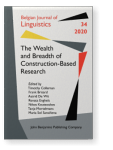Pleonastic complex words as functional amalgams
Syntactic amalgams are innovative phrasal constructions that combine otherwise incompatible subparts of other
constructions (Lambrecht 1988; Brenier and Michaelis
2005). We describe pleonastic formations like flavorize in English and ψηλαφ-ίζ(ω) [psilafízo]
‘palpate’ in Modern Greek as functional amalgams at the word level. We examine these formations through the lens of (function-oriented)
Sign-Based Construction Grammar (Sag 2012), arguing that once we see
derivational morphemes as signs, and sign combination as construction-driven rather than head-driven, we can describe such words as coercive
combinations that serve a variety of semiotic functions.
Article outline
- 1.Introduction
- 2.IME in English and Modern Greek
- 3.Headedness in morphology
- 4.A SBCG approach to derivational suffixes
- 5.Functional analysis of IME formations
- 5.1Word-level amalgams
- 5.2IME as construction-based selection
- 6.Conclusion
- Acknowledgements
- Notes
-
References
